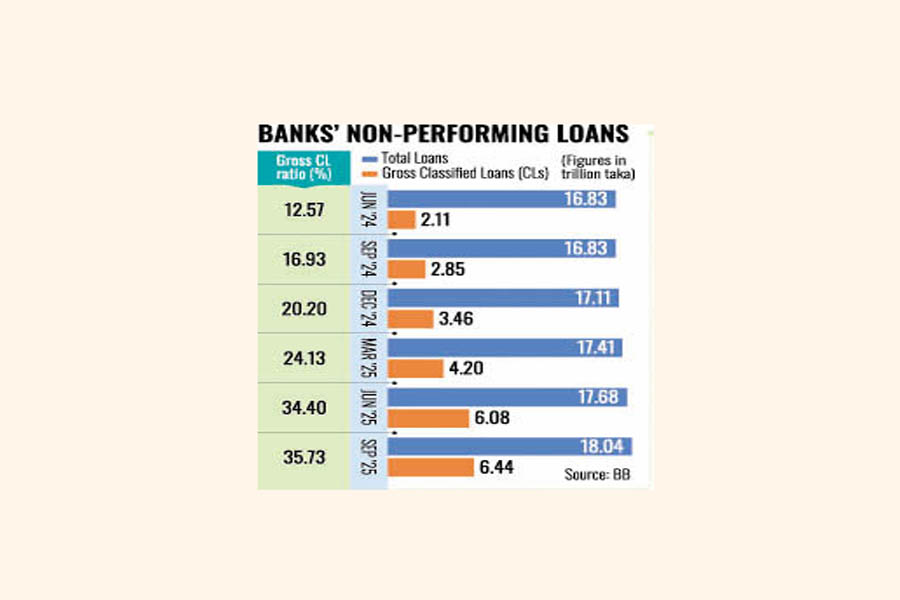Quantum leap of Tk 2.24t in just six months
Banks’ NPL balloons to Tk 6.44t in Sept count
Aggregate NPL buildup nears 36pc of total outstanding loans

Published :
Updated :

Banks in Bangladesh gasp under a burden of bad loans as the aggregate volume makes a quantum leap by over Tk 2.24 trillion in just six months to a record high until September.
As per latest-available data until last September, with the fast rise in non-performing loans (NPLs), the outstanding of the classified loans in the country's banking system balloons over Tk 6.44 trillion, accounting for 35.73 per cent of the entire loans worth Tk 18.04 trillion disbursed by the commercial banks.
In fact, the burden of NPLs in banks has more than doubled in just a year as the figure was Tk 2.85 trillion until September 2024 and the ratio 16.93 per cent.
The mammoth growth in bad loans has been posing multipronged strains for the banking industry with serious disruptions done to their liquidity management. As matter of fact, the banks' profitability is also dented as they have to maintain a portion of funds for NPL provisioning.
Officials and bankers say the industry has witnessed a quantum leap in the volume of classified loans since March this year when the central bank revised overdue-status-counting system for term lending to a curtailed tenure of three months from previous six months.
The gross volume of NPL is almost double the total tax revenues worth Tk 3.71 trillion collected by the National Board of Revenue (NBR) in FY'25
According to central bank statistics, the share of classified loans rose to 35.73 per cent of the total outstanding loans during the period under review from 16.93 per cent a year before.
In terms of net calculations, the volume of classified loans stands at Tk 4.16 trillion by the end of September last and the ratio is 26.40 per cent. By June-end, the net volume of classified loans and ratio were Tk 3.88 trillion and 25.08 per cent respectively.
Regarding net NPL calculation, the Bangladesh Bank states that the net NPL method gives a clearer picture of loan defaults. It works by deducting provisions and suspended interest from gross figures, showing only the part of loans still uncovered.
In practice, net NPL is calculated by taking bad loans, deducting the amounts already set aside and dividing by total loans after the same deductions. This highlights the share of loans that remain truly at risk.
For example, if Tk 1.0 billion in loans is classified as bad, with Tk 100 million in suspended interest and Tk 400 million in provisions, the uncovered portion is Tk 500 million. Against total loans of Tk 10 billion, the net NPL ratio comes to 5.26 per cent.
The central bank says this arithmetic is important because it identifies actual risk, provides a more accurate picture of financial health, and shows banks' capacity to absorb losses.
Such faster NPL buildups in banks cause serious concerns to bankers who fear further pressure on their liquidity situation in the months ahead.
Managing director of Shahjalal Islami Bank PLC Mosleh Uddin Ahmed says the banking regulator has been applying RBS (risk-based supervision) tools. Under the system, the banks need to provide some 200 data, which are inter-connected.
"There is no scope for banks to keep something under the carpet anymore. So, the real picture of NPL in banks started getting exposed in the changed context now," says the seasoned banker.
Such negative things started affecting people's trust on the banking industry. "Can we really absorb such pressure in a short span of time? I think it would be better if the banks are allowed some time to get corrected gradually," he adds.
Managing director and chief executive director (CEO) of Modhumoti Bank PLC Md. Shafiul Azam says many banks did not disclose real picture of the burden. But now things like NPL-counting method changed. So banks have no other option but to disclose everything.
On the other hand, the experienced banker says, there are many borrowers who pass through difficulties because of persisting economic sluggishness, which is also contributing to the rise in classified loans in banks.
"And it has badly been affecting banks' profit earnings, liquidity management and image locally and globally," he notes.
Managing Director and CEO of Mutual Trust Bank (MTB) PLC Syed Mahbubur Rahman thinks the mammoth NPL growth is not something unexpected and surprising.
But, the central bank took various steps like policy support aimed at restoring the struggling business and financial operations of both classified and unclassified borrowers.
"I think such facility will help lessen the burden in the coming days," the experienced banker says.
jubairfe1980@gmail.com


 For all latest news, follow The Financial Express Google News channel.
For all latest news, follow The Financial Express Google News channel.